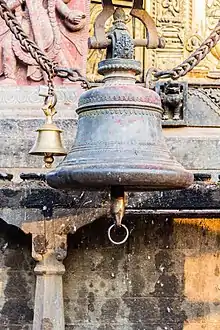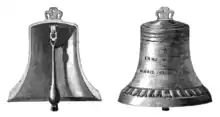Ghanta
Ghanta (Sanskrit: घण्टा, IAST: ghaṇṭā; Tibetan: drilbu) is the Sanskrit term for a ritual bell used in Hinduistic religious practices. The ringing of the bell produces what is regarded as an auspicious sound. Hindu temples generally have one metal bell hanging at the entrance and devotees ring the bell while entering the temple which is an essential part in preparation of having a darshan.[1] A bell is also rung by priests during Pūjā or Yajna - during the waving of light, burning of incense in front of the deity, while bathing the deity and while offering food or flowers.[2] There are bells specially made to produce the long strains of the sound Aum.[3]


| Part of a series on |
| Shaivism |
|---|
 |
Description
The bell is generally made out of brass. A clapper is attached to the inside and the bell makes a high pitched sound when rung. The top of the bell handle is usually adorned with a brass figure - bells intended for use in the worship of Lord Shiva will have a figure of Lord Nandi, while those used in the worship of Lord Vishnu or his avatars as Rama, Narasimha or Krishna will have a figure of Garuda or Panchajanya shanka or Sudarshana Chakra.[2]
Usage
In Hinduism, bells are generally hung at the temple dome in front of the Garbhagriha. Generally, devotees ring the bell while entering into the sanctum. It is said that by ringing the bell, the devotee informs the deity of his/her arrival. The sound of the bell is considered auspicious which welcomes divinity and dispels evil.[4] The sound of the bell is said to disengage mind from ongoing thoughts thus making the mind more receptive.[5] Bell ringing during prayer is said to help in controlling the ever wandering mind and focusing on the deity.[2]

Mantra
In Hinduism, the mantra chanted while ringing the bell is[6]
Aagamaardhamtu devaanaam gamanaardhamtu rakshasaam, Kuru ghantaaravam krutva devataahvaana lanchanam
I ring this bell indicating the invocation of divinity, so that virtuous and noble forces enter; and the demonic and evil forces, from within and without, depart.
Yogic View
From Kundalini Yoga perspective, the sound of bell energizes Chakras and balances the distribution of energy in body. Also, the number of times the bell should be sounded depends on the number of letters in the mantra; accordingly the bell should be sounded 8, 16, 24, or 32 times. In Shilpa Shastras it is mentioned that bell should be made of panchadhatu - five metals, namely, copper, silver, gold, zinc and iron. These 5 metals represent the pancha bhoota.[7]
Symbolism

Bells have symbolic meaning in Hinduism. The curved body of the bell represents Ananta. The clapper or tongue of the bell represents Saraswati, who is the goddess of wisdom and knowledge. The handle of the bell represents Prana Shakti - vital power and is symbolically linked to Hanuman, Garuda, Nandi (bull) or Sudarshana Chakra.[8]
See also
References
- http://bharathkidilse.blogspot.com.ee/2009/10/bell-ghanta.html
- https://www.templepurohit.com/why-do-we-ring-bells-or-ghanta-in-hindu-temples/
- "Why do people ring a bell on entering a mandir". Retrieved on 13 March 2015
- "Why do we ring the bell in a temple?"
- "Peal of bells". Retrieved on 4 March 2015
- "Hindu rituals". Retrieved on 9 March 2015
- "Why to ring the bell while coming to Temple or starting any pooja?". Retrieved on 9 March 2015
- "Why do Hindus ring the bell in temple". Retrieved on 3 March 2015



